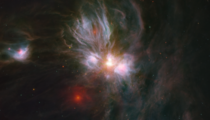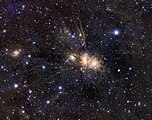NGC 2170
| Reflexionsnebel | |
|---|---|
| NGC 2170 | |
 | |
| Der Reflexionsnebel aufgenommen im sichtbaren Spektralbereich mit dem 81-cm-Spiegelteleskop des Mount-Lemmon-Observatoriums | |
| Sternbild | Einhorn |
| Position Äquinoktium: J2000.0 | |
| Rektaszension | 06h 07m 31,8s [1] |
| Deklination | -06° 23′ 57″ [1] |
| Weitere Daten | |
| Winkelausdehnung | 2′ × 2′ [2] |
| Geschichte | |
| Entdeckung | William Herschel |
| Datum der Entdeckung | 16. Oktober 1784 |
| Katalogbezeichnungen | |
| NGC 2170 • Ced 63 • LBN 994 • H IV 19 • GC 1362 | |
| Aladin previewer | |
NGC 2170 ist ein Reflexionsnebel im Sternbild Einhorn südlich des Himmelsäquators, der rund 2700 Lichtjahre vom Sonnensystem entfernt ist.
Das Objekt wurde am 16. Oktober 1784 von William Herschel entdeckt.[3]
Infrarotaufnahme mithilfe des Spitzer-Weltraumobservatoriums und des Wide-Field Infrared Survey Explorers.
Infrarotaufnahme mit VISTA
Weblinks
- Spektrum.de: Amateuraufnahmen [1][2]
- ESO: VISTA enthüllt das Geheimnis des Einhorns (+Fotos,Karte&Animationen) 6. Oktober 2010
- SIMBAD: NGC 2170
Einzelnachweise
Auf dieser Seite verwendete Medien
Autor/Urheber: ESO/J. Emerson/VISTA, Lizenz: CC BY 4.0
This dramatic infrared image shows the nearby star formation region Monoceros R2, located some 2700 light-years away in the constellation of Monoceros (the Unicorn). The picture was created from exposures in the near infrared bands Y, J and Ks taken by the VISTA survey telescope at ESO’s Paranal Observatory. Monoceros R2 is an association of massive hot young stars illuminating a beautiful collection of reflection nebulae, embedded in a large molecular cloud.
Autor/Urheber: Credit Line and Copyright Adam Block/Mount Lemmon SkyCenter/University of Arizona, Lizenz: CC BY-SA 3.0 us
NGC 2170
Picture Details:
Optics 32-inch Schulman Telescope (RC Optical Systems)
Camera SBIG STL11000 CCD Camera
Filters Custom Scientific
Dates December 4th 2010
Location Mount Lemmon SkyCenter
Exposure LRGB = 260:70:70:80 minutes
Acquisition ACP Observatory Control Software (DC-3 Dreams),TheSky (Software Bisque), Maxim DL/CCD (Cyanogen)
Processing CCDStack (CCDWare), Photoshop CS3 (Adobe)
Credit Line and Copyright
Adam Block/Mount Lemmon SkyCenter/University of Arizona
. Autor/Urheber: Judy Schmidt from Fresh Meadows, NY, USA, Lizenz: CC BY 2.0
NGC 2170 is one of those nebulas which, in visible light, is difficult to forget. So striking are these tendrils of dust once they are fully revealed, one cannot help associating some kind of emotion with it. I personally find it to be dark and brooding.
These dusty star-forming regions tend to also be interesting in infrared, so I decided to see what kind of data was available in the archives. Lo and behold, Spitzer had observed the region in my favorite bands and so I set forth to compose this.
Unfortunately, it was a very troubled procedure. The most important channel—the 8μm one that I use to sharpen the whole image by applying it as a luminosity layer—was terrible. It was full of these blocky edges with some of the tiles having a bunch of extra light stuck in them, presumably from the zodiacal glow. Whatever it all went through (they call it a pipeline) didn't remove all that extra light, so I had to do it myself. I was moderately successful, but there are still things that aren't quite right with it.
Anyway, the bright spot in the center was also so bright that it easily saturated the detectors from both the Spitzer and the WISE telescopes. That does happen all the time, but it seemed extra annoying somehow. What this means simply is that there is a load of star formation going on in there. When looking at these particular infrared bands I find it's easier to think in terms of dust rather than stars, though. Sure, there are points of light that are stars, but it seems to me that without the dust component they'd all be oddly invisible.
Red: Spitzer/MIPS24 (24μm) Green: WISE/W3 (12μm) Blue: Spitzer/IRAC4 (8μm)
North is up.



